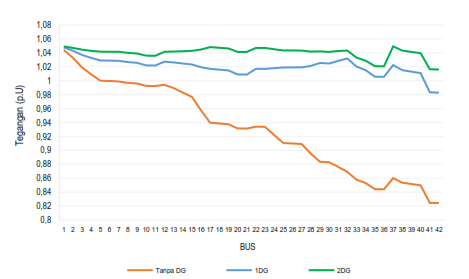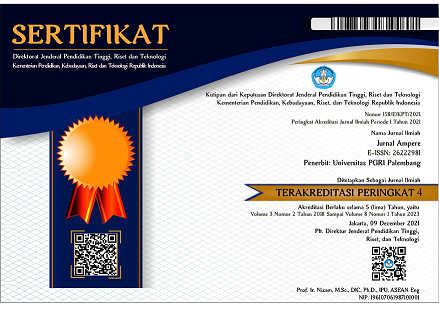Penentuan Lokasi dan Kapasitas Distributed Generation Pada Sistem Distribusi Penyulang Semanu Dengan Flower Pollination Algorithm
DOI:
https://doi.org/10.31851/ampere.v9i1.15205Keywords:
Distributed Generation, FPA, Rugi-rugi daya, Profil TeganganAbstract
Pemasangan Distributed Generation (DG) memiliki manfaat diantaranya untuk mengurangi rugi-rugi daya, memperbaiki nilai tegangan dan meningkatkan kualitas daya pada sistem distribusi. Lokasi penempatan DG dan kapasitas DG yang tidak optimal pada sistem dapat meningkatkan rugi-rugi daya yang dapat mempengaruhi turunnya profil tegangan. Penelitian ini mengusulkan algoritma optimasi Flower Pollination Algorithm (FPA) untuk menentukan penempatan lokasi untuk mengurangi rugi-rugi daya dan menentukan kapasitas DG yang optimal pada studi kasus jaringan distribusi Semanu, Yogyakarta. Penelitian yang dibagi menjadi dua skenario dimana pada skenario pemasangan satu/single DG didapat lokasi yang optimal terletak di Bus 32, dengan kapasitas 8307,47 kW dan rugi-rugi daya menurun 70,41%. Pada skenario pemasangan dua/multi-DG lokasi yang optimal terletak di Bus 17 dan 37 masing-masing berkapasitas 4479,46 kW dan 5294,91 kW, dan rugi-rugi daya menurun 81,22%. Pemasangan multi-DG lebih andal dibandingkan dengan satu/single DG karena memiliki rugi-rugi daya yang lebih minimum.
References
M. Mohammadi and M. Nafar, “Optimal placement of multitypes DG as independent private sector under pool/hybrid power market using GA-based Tabu Search method,” International Journal of Electrical Power and Energy Systems, vol. 51, pp. 43–53, 2013, doi: 10.1016/j.ijepes.2013.03.003.
M. S. Yahaya, M. F. Basar, Z. Ibrahim, M. N. N. Nasir, M. Y. Lada, and W. M. Bukhari, “A review on the impact of embedded generation to network fault level,” AIP Conf Proc, vol. 1660, no. 1, p. 70044, May 2015, doi: 10.1063/1.4915762.
K. Nadhir, D. Chabane, and B. Tarek, “Firefly algorithm for optimal allocation and sizing of Distributed Generation in radial distribution system for loss minimization,” 2013 International Conference on Control, Decision and Information Technologies, CoDIT 2013, pp. 231–235, 2013, doi: 10.1109/CoDIT.2013.6689549.
M. Pesaran H.A, P. D. Huy, and V. K. Ramachandaramurthy, “A review of the optimal allocation of distributed generation: Objectives, constraints, methods, and algorithms,” Renewable and Sustainable Energy Reviews, vol. 75, no. November 2016, pp. 293–312, 2017, doi: 10.1016/j.rser.2016.10.071.
Jimmy Trio Putra, “Optimasi Daya Reaktif Distributed Generation untuk Pengaturan Tegangan Sistem Distribusi dan Transmisi Tenaga Listrik,” Universitas Gadjah Mada, 2015.
A. K. Parizad. A, M. Kalantar, “Optimal Placement of Distributed Generation with Sensitivity Factors Considering Voltage Stability and Losses Indices,” 18th Iranian Conference on Electrical Engineering, pp. 848–855, doi: 10.1109/IRANIANCEE.2010.5506959.
S. R. A. Rahim, I. Musirin, M. H. Sulaiman, M. H. Hussain, and A. Azmi, “Assessing the Performance of DG in Distribution Network,” 2012 IEEE International Power Engineering and Optimization Conference Melaka, Malaysia, no. June, pp. 436–441, 2012, doi: 10.1109/PEOCO.2012.6230904.
V. Kumar, S. O. P. Rahi, V. Kumar, and J. S. Kuntal, “Optimal Placement Methods of Distributed Generation : A Review,” pp. 978–981, 2012, doi: 10.3850/978-981-07-1847-3.
K. Mahesh, P. Nallagownden, and I. Elamvazuthi, “Optimal Configuration of DG in Distribution System : An Overview,” vol. 7, pp. 1–5.
D. Agarwal, S. A. Siddiqui, and N. K. Swarnkar, “GA based Optimal DG Placement for Power Loss Reduction and Voltage Stability Improvement,” vol. 5, no. 04, pp. 558–563, 2016.
A. Ameli, S. Member, S. Bahrami, S. Member, and F. Khazaeli, “A Multiobjective Particle Swarm Optimization for Sizing and Placement of DGs from DG Owner ’ s and Distribution Company ’ s Viewpoints,” vol. 29, no. 4, pp. 1831–1840, 2014.
X.-S. Yang, “Flower Pollination Algorithm for Global Optimization BT - Unconventional Computation and Natural Computation,” J. Durand-Lose and N. Jonoska, Eds., Berlin, Heidelberg: Springer Berlin Heidelberg, 2012, pp. 240–249.
B. F. W. and G. B. S. Allen J Wood, “Power Generation Operation and Control 3rd edition”.
Dian Budi Santoso, “Optimisasi Penempatan Dan Kapasitas Wind-Based Distributed Generation Untuk Minimisasi Losses Menggunakan Flower Pollination Algorithm,” Thesis. Program Pascasarjana Fakultas Teknik Universitas Gadjah Mada Yogyakarta., vol. 101, p. 10, 2017.
B. V. Reddy, “Sizing of DG Units Using Exact Loss Formula to Improve Efficiency of Radial Distribution System,” International Journal of Emerging Trends in Electrical and Electronics, vol. 10, no. 1, pp. 13–17, 2014, [Online]. Available: http://www.iret.co.in/Docs/IJETEE/Volume 10/Issue11/3. Sizing of DG Units Using Exact Loss Formula to Improve Efficiency of Radial Distribution System.pdf
Kementerian Energi dan Sumber Daya Mineral Republik Indonesia, “Peraturan Menteri ESDM No. 03 Tahun 2007 Tentang Aturan Jaringan Sistem Tenaga Listrik Jawa-Madura-Bali,” 2007.
Y. X.-S, Flower Pollination Algorithm for Global Optimization, vol. 9, no. 3. 2014. doi: 10.1016/j.arr.2010.02.003.
“OpenDSS.” Accessed: Des. 12, 2023. [Online]. Available: https://sourceforge.net/projects/electricdss/

Downloads
Published
How to Cite
Issue
Section
License
Copyright (c) 2024 Tegar Prasetyo, Muhammad Amri Yahya, Dyah Utari Yusa Wardhani, Ali Muhtar, Fredi Prima Sakti

This work is licensed under a Creative Commons Attribution-ShareAlike 4.0 International License.

Jurnal Ampere is licensed under a Creative Commons Attribution-ShareAlike 4.0 International License.
Authors who publish with this journal agree to the following terms:
- Authors retain copyright and grant the journal right of first publication with the work simultaneously licensed under a Creative Commons Attribution License that allows others to share the work with an acknowledgement of the work's authorship and initial publication in this journal.
- Authors are able to enter into separate, additional contractual arrangements for the non-exclusive distribution of the journal's published version of the work (e.g., post it to an institutional repository or publish it in a book), with an acknowledgement of its initial publication in this journal.
- Authors are permitted and encouraged to post their work online (e.g., in institutional repositories or on their website) prior to and during the submission process, as it can lead to productive exchanges, as well as earlier and greater citation of published work.





